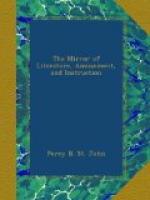In the reign of the Emperor Constantine the Great, his mother Helena, when almost an octogenarian, undertook a pilgrimage to Jerusalem. Her pious zeal was particularly directed to the search of the holy sepulchre, and of the cross on which Jesus Christ had suffered; and, according to her own judgment: at least, she was successful in both. A vision, or perhaps a dream, disclosed the place of the Holy Sepulchre; the three crosses were found buried near it, and that of the Saviour is said to have been distinguished from the others by its healing powers on the sick, and even restoring a corpse to life. This discovery caused great and general rejoicing throughout Christendom.[3] The spot was immediately consecrated by a church, called the New Jerusalem, and of such magnificence that the celebrated Eusebius is strongly inclined to look upon its building as the fulfilment of the prophecies in the Scriptures for a city of that name.[4] A verse of the sibyl was also remembered or composed, which, like all predictions after the event, tallied in a surprising manner with the holy object so happily revealed. The greater share of the Cross was left at Jerusalem, set in a case of silver, and the remainder was sent to Constantine, who, in hopes of securing the prosperity and duration of his empire, enclosed it within his own statue on the Byzantine Forum. The pilgrims also, who thronged to Jerusalem during a long course of years, were always eager, and often successful, in obtaining a small fragment of the cross for themselves; so that at length, according to the strong expression of St. Cyril, the whole earth was filled with this sacred wood. Even at present, there is scarcely a Roman Catholic cathedral which does not display some pretended pieces of this relic; and it has been computed, with some exaggeration, that were they all collected together, they might prove sufficient for building a ship of the line. To account for this extraordinary diffusion of so limited a quantity, the Catholic writers have been obliged to assert its preternatural growth and vegetation, which the saint already quoted ingeniously compares to the miracle of the loaves and fishes.[5] That the guardians of this cross at Jerusalem should have had recourse to such evident and undoubted falsehood, should, I think, very much increase our doubts whether the Cross itself was genuine, and whether the old age and credulity of Helena, may not have been grossly imposed upon. Where we see one fraud, we may justly suspect another. From this period, however, the history of this fragment of wood may be clearly and accurately traced during the twelve succeeding centuries.




